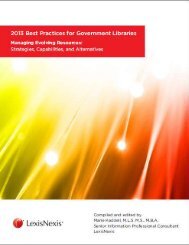2012 Best Practices for Government Libraries
2012 Best Practices for Government Libraries
2012 Best Practices for Government Libraries
Create successful ePaper yourself
Turn your PDF publications into a flip-book with our unique Google optimized e-Paper software.
157<br />
BEST PRACTICES <strong>2012</strong><br />
<strong>Government</strong> In<strong>for</strong>mation, noted that government entities were making enormous<br />
amounts of digital in<strong>for</strong>mation available to the public, but most were failing to<br />
manage the entire lifecycle of electronic government in<strong>for</strong>mation from its creation<br />
to its preservation, ensuring permanent public access along the way.<br />
In March of 2007 they followed this up with the State-By-State Report on<br />
Authentication of Online Legal Resources, documenting the relative trustworthiness<br />
of state-level primary legal resources on the web. The report didn’t mince words:<br />
A significant number of the state online legal resources are official but none<br />
are authenticated or af<strong>for</strong>d ready authentication by standard methods. State<br />
online primary legal resources are there<strong>for</strong>e not sufficiently trustworthy.<br />
In other words, if you can’t authenticate digital resources you can’t trust them. And<br />
if organizations (i.e. lawyers) can’t “trust” electronic documents, they’re going to<br />
insist on paper documents instead, building a chain of distrust that works against<br />
the creation, use and (eventually) the preservation of digital in<strong>for</strong>mation.<br />
The AALL activities were supported by concurrent activities taking place in the GPO<br />
and in a variety of other government agencies. The National Digital In<strong>for</strong>mation<br />
Infrastructure and Preservation Program at the Library of Congress funded the work<br />
of the Model Technological and Social Architecture <strong>for</strong> the Preservation of State<br />
<strong>Government</strong> Digital In<strong>for</strong>mation (MTSA) project, led by the Minnesota Historical<br />
Society. MTSA explored the challenges of stewarding, preserving and providing<br />
enhanced long-term access to legislative digital records.<br />
When MTSA started in 2007 they entered the fray as state governments were<br />
accelerating the movement away from paper-based authoring of official legislative<br />
in<strong>for</strong>mation to entirely digital workflows, including ones with digital materials as the<br />
only officially published document.<br />
The project focused significant attention on the “access” component of the lifecycle<br />
of in<strong>for</strong>mation, as they recognized early on that access was an effective catalyst <strong>for</strong><br />
investment; by demonstrating immediate value to funding sources and important<br />
constituencies, they determined that it would be easier to justify and develop<br />
support <strong>for</strong> preservation.<br />
MTSA also recognized that these issues couldn’t be resolved by librarians and<br />
archivists acting in isolation. With that in mind, they worked with a diverse coalition<br />
of participants, including those that write the bills, committee reports, floor<br />
proceedings and other legislative materials (such as the Minnesota Office of the<br />
Revisor of Statutes); those that manage the technology that keeps the legislature<br />
running (the Kansas Legislative Computer Services); national organizations that<br />
provide research and technical assistance to state government policymakers on a



